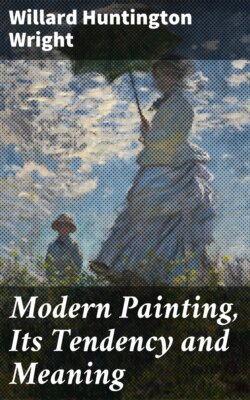Modern Painting, Its Tendency and Meaning

Реклама. ООО «ЛитРес», ИНН: 7719571260.
Оглавление
Willard Huntington Wright. Modern Painting, Its Tendency and Meaning
Modern Painting, Its Tendency and Meaning
Table of Contents
FOREWORD
REPRODUCTIONS
Modern Painting
I. ANCIENT AND MODERN ART
II. PRECURSORS OF THE NEW ERA
III. ÉDOUARD MANET
IV. THE EARLY IMPRESSIONISTS
V. AUGUSTE RENOIR
VI. PAUL CÉZANNE
VII. THE NEO-IMPRESSIONISTS
VIII. GAUGUIN AND THE PONT-AVEN SCHOOL
IX. DEGAS AND HIS CIRCLE
X. HENRI-MATISSE
XI. PICASSO AND CUBISM
XII. FUTURISM
XIII. SYNCHROMISM
XIV. THE LESSER MODERNS
XV. CONCLUSION
INDEX
OTHER BOOKS BY WILLARD HUNTINGTON WRIGHT. WHAT NIETZSCHE TAUGHT
THE PRINCIPLES OF ÆSTHETIC FORM AND ORGANISATION (In Preparation)
THE MAN OF PROMISE (To be published January, 1916)
Отрывок из книги
Willard Huntington Wright
Published by Good Press, 2021
.....
Cézanne, looking into their habits more coolly, saw their restrictions. While achieving all their atmospheric aims, he went deeper into the mechanics of colour, and with this knowledge achieved form as well as light. This was another step forward in the development of modern methods. With him colour began to near its true and ultimate significance as a functioning element. Later, with the aid of the scientists, Chevreul, Bourgeois, Helmholtz and Rood, other artists made various departures into the field of colour, but their enterprises were failures. Then came Matisse who made improvements on the harmonic side of colour. But because he ignored the profounder lessons of Cézanne he succeeded only in the fabrication of a highly organised decorative art. Not until the advent of the Synchromists, whose first public exhibition took place in Munich in 1913, were any further crucial advances made. These artists completed Cézanne in that they rationalised his dimly foreshadowed precepts.
To understand the basic significance of painting it is necessary to revise our method of judgment. As yet no æsthetician has recorded a rationale for art valuation. Taine put forth many illuminating suggestions regarding the fundamentals of form, but the critics have paid scant heed. Prejudice, personal taste, metaphysics and even the predilections of sentiment, still govern the world’s judgments and appreciations. We are slaves to accuracy of delineation, to prettiness of design, to the whole suite of material considerations which are deputies to the organic and intellectual qualities of a work of art. It is the common thing to find criticisms—ever from the highest sources—which praise or condemn a picture according to the nearness of its approach to the reality of its subject. Such observations are confusing and irrelevant. Were realism the object of art, painting would always be infinitely inferior to life—a mere simulacrum of our daily existence, ever inadequate in its illusion. The moment we attach other than purely æsthetic values to paintings—either ancient or modern—we are confronted by so extensive and differentiated a set of tests that chaos or error is unavoidable. In the end we shall find that our conclusions have their premises, not in the work of art itself, but in personal and extraneous considerations. A picture to be a great work of art need not contain any recognisable objects. Provided it gives the sensation of rhythmically balanced form in three dimensions, it will have accomplished all that the greatest masters of art have ever striven for.
.....